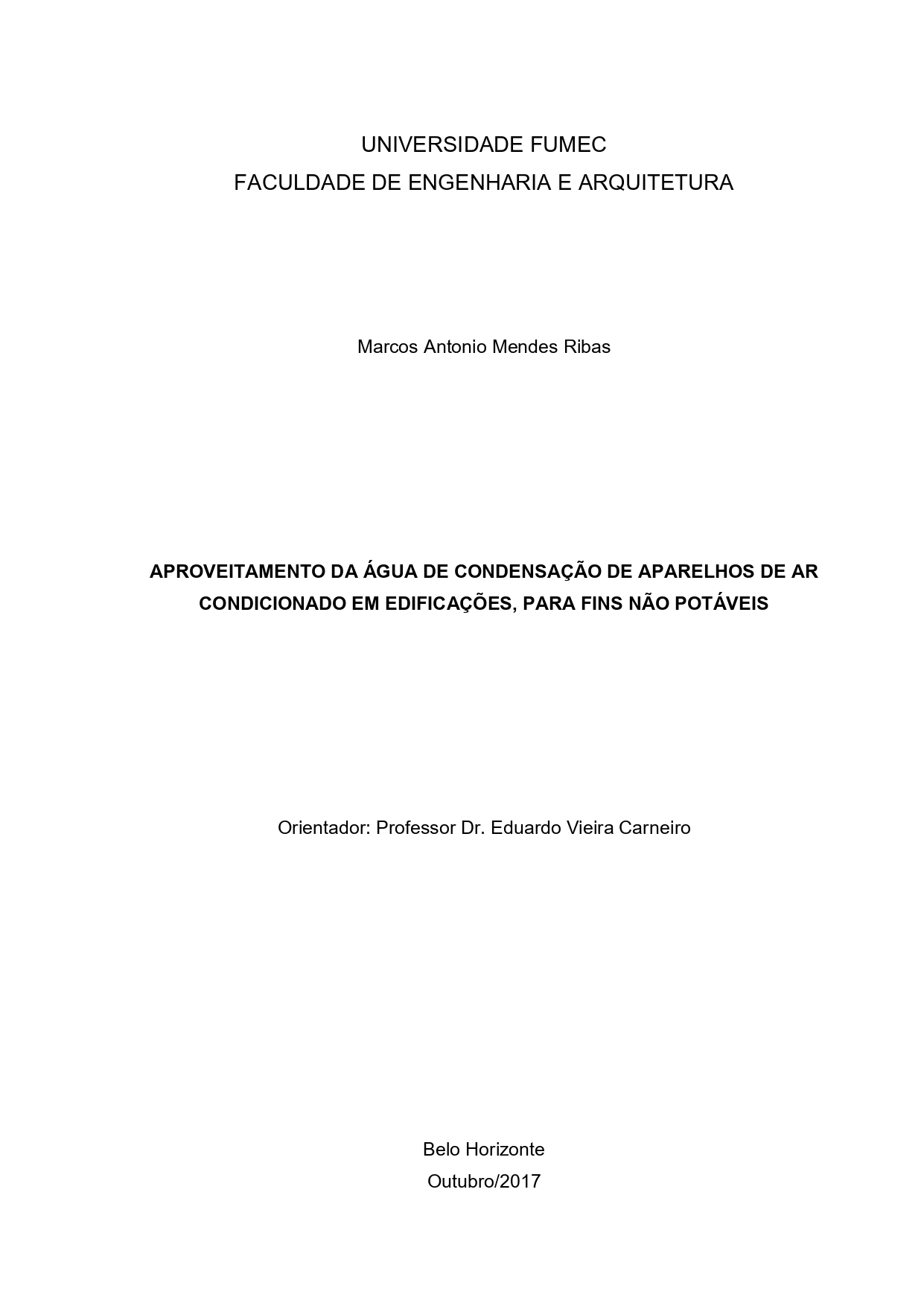Aproveitamento da água de condensação de aparelhos de ar condicionado em edificações, para fins não potáveis

Visualizar/
Data
2017Autor
Ribas, Marcos Antonio Mendes
xmlui.mirage2.itemSummaryView.MetaData
Mostrar registro completoResumo
O presente trabalho consiste em um estudo avaliativo do aproveitamento da água de condensação dos aparelhos de ar condicionado em edificações, para fins não potáveis. Os dados do estudo foram levantados do sistema de condicionamento de ar do prédio Sede da Copasa – MG, em Belo Horizonte. Para a obtenção dos dados redirecionou-se a rede drenante da água condensada já existente, que antes era despejada no sistema pluvial do município, com a finalidade de possibilitar todo o seu armazenamento em reservatórios distribuídos pelo prédio. As coletas das amostras ocorreram durante o inverno, período crítico em que há uma redução da água condensada. Nesta época do ano as temperaturas são mais amenas e praticamente não chove, fatores que reduzem a umidade do ar e também o uso dos aparelhos de ar condicionado, interferindo consequentemente no volume de água condensada produzida. Durante o estudo foram levantados os modelos e a potência dos equipamentos de ar condicionado que estão presentes no prédio. No decorrer da coleta verificou-se diariamente a temperatura ambiente, a umidade relativa do ar, a pressão atmosférica e mediu-se o volume de água condensada produzido. Neste período foram apurados dados sobre o clima em Belo Horizonte e, a partir da medição do volume de água condensada gerada diariamente, buscou-se relacionar a quantidade de água condensada produzida com a variação da temperatura, pressão, umidade do ar e também com a potência dos aparelhos de ar condicionado. Após o monitoramento e a coleta das informações, toda a água residual foi liberada para uso em atividades no local, tais como irrigação de jardins, limpeza de banheiros, lavação de pátios e veículos. O volume de água condensada gerado no período foi de, aproximadamente, 5.000 litros. Foram coletadas amostras dos quatro pontos de coleta, com a finalidade de avaliar a qualidade bacteriológica da água e, assim, evitar eventual risco com o seu reuso. Os resultados das análises indicaram negativo para coliformes totais e Escherichia coli, confirmando a qualidade da água. Baseado nos resultados obtidos com a avaliação quantitativa e qualitativa da água de condensação dos aparelhos de ar condicionado, seu uso para fins não potáveis deve ser estimulado The present work consists of an evaluative study of the use of condensation water for air conditioning units in buildings, for non potable purposes. The study data were collected from the air conditioning system of the headquarters building of Copasa - MG, in Belo Horizonte. To obtain the data, the drainage network of the existing condensed water was redirected, which was previously dumped in the municipality's pluvial system, in order to allow all its storage in reservoirs distributed throughout the building. Sample collection occurred during the winter, a critical period in which there is a reduction of condensed water. At this time of year temperatures are milder and practically no rain, factors that reduce the humidity of the air and also the use of air conditioners, thus interfering in the volume of condensed water produced. During the study the models and the power of the air conditioning equipments that are present in the building were raised. During the collection, the ambient temperature, the relative humidity of the air and the atmospheric pressure were measured daily and the volume of condensed water produced was measured. In this period, data were collected on the climate in Belo Horizonte and, based on the daily volume of condensed water, it was searched the amount of condensed water produced with the variation of temperature, pressure, humidity of the air and also with the power of air conditioners. After monitoring and collecting the information, all wastewater was released for use in on-site activities such as garden irrigation, toilet cleaning, yard and vehicle washes. The volume of condensed water generated in the period was approximately 5,000 liters. Samples were collected from the four collection points, in order to evaluate the bacteriological quality of the water and thus avoid possible risk with its reuse. The results of the analyzes indicated negative for total coliforms and Escherichia coli, confirming the quality of the water. Based on the results obtained with the quantitative and qualitative evaluation of the condensation water of the air conditioners, their use for non potable purposes should be stimulated.
